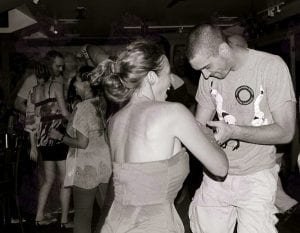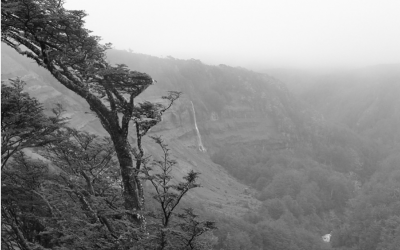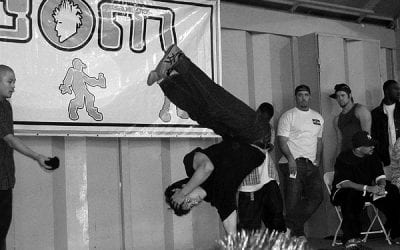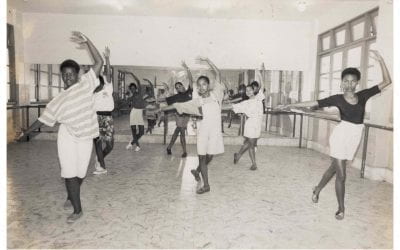The Fun of Forró

“Hifi Forro Dancing L’orange Bleue 8/23/10 NYC” by purplevintagespaceprincess is licensed under CC BY-ND 2.0
I went with my friend Denise and her boyfriend to the Gafieira Estudantina for a night of forró. Last year, I used to see the Estudantina’s hand-painted dance banner hanging from its second-floor balcony, whenever I was walking around the Praca Tiradentes in Rio de Janeiro. But I’d never been up there. The Estudantina, it turns out, is one of Rio’s old ballroom dance halls (gafieiras)—founded in 1932. Denise told me her mother used to come there to dance in the 1940s, and she’d come there to dance in the 1980s, and now here we were in 2006. Estudantina now hosts a mixed selection of forro, samba and all kinds of modern stuff, but always forro on Thursdays.
Forro (fuh-HAW) is the earthy, folksy country dance of Brazil. It’s what Brazilians dance when they want a fun, down-home dance for flirting up close with their partners, instead of the fast, showy samba. It’s rather like the niche that country two-step has in the United States. Forro’s very popular in Rio, and most of the big clubs have a forro night at least once a week.
I’d seen a little forro before but this was the first time I had seen the “pé-de-serra” style— “foothills of the interior” style, that is, really authentic country style forro with zabumba, accordion, triangle and a singer. Zabumba’s one of my favorite Brazilian drums; it’s a big double-headed bass drum played with a thumpy bass mallet in one hand, while the other hand plays wickedly fast syncopations with a little switch stick on the other side of the drum. (Plus, it’s got the all-time best drum name: Zah-BOOM-bah!) They were playing mostly baiao rhythm but with an occasional slower xaxado, and sometimes a faster thing that I was told later was arrasta-pé (“foot-dragger”).
Later I tried to demonstrate to my friends the proper hand-hold for forro, as far as I could tell from my experience: woman’s right hand clasped loosely in man’s left, woman’s left hand on man’s shoulder, and man’s right hand slowly sliding down the woman’s back all the way down into her jeans and clear down to her underwear. Woman’s left hand periodically reaching back to man’s right hand and pulling it back up a good foot or so.
Eventually a player came up on stage with an odd-looking unvarnished fiddle. My first sight of a rabeca, the Brazilian fiddle. He was holding it folk-style, low on the chest, and was using an old 19th-century style handmade wooden bow. He started playing the most incredibly beautiful solo and my jaw almost hit the floor. SO gorgeous. Then the band entered. Wow. First of all, wow, it was so beautiful; and second of all, wow, I could have been in Louisiana, it was now so like Cajun fiddle music—the style of the melody, the way it flowed, the marriage with triangle and accordion, the voice wailing over the top of it all. The only difference was just that syncopated kick of the zabumba.
It was truly beautiful. I have a weak spot anyway for folk fiddle. (I used to play bowed bass in a Hungarian gypsy fiddle band, and also have a substantial weakness for Cajun, Cape Breton and Irish fiddle traditions.) I stood there watching the rabeca player, and thought “I have been such a damn samba snob, to have ignored forro all this time.”
The dancing crowd of men and women pressed tight even seemed to be doing pure Louisiana zydeco dance! I swear, it was eerily similar to zydeco – in basic form, in footwork, in the hip movement, and even in the pressed-tight body style. (Sooooo tight it reminded me of the Simpsons episode where they go to Brazil and see all the Brazilian dances: “the Lambada, the Macarena… and the Penetrada.”)
The similarity of the music to Cajun, and of the dance to zydeco, still puzzles me. Doing a little Google for “Cajun” and “forro” today, I found that many accordion players have picked up on the odd similarity too. I read a note by an experienced zydeco dancer who had seen the recent Brazilian documentary “Saudade do Futuro” and was amazed to see Brazilians dancing what appeared to be pure zydeco. Later I remembered that forro is thought to have been influenced by dances held “for all” (= “forro”) by US Air Force stationed in Natal (just north of Recife) during World War II. Could there have been a Louisiana fiddler at that Air Force base?
If you go: For a guided tour of Rio’s authentic old dance halls, with plenty of time for dancing, contact Denise at Rio Hiking and ask about the Nightlife Tour.
Kathleen Hunt is a biologist who used to study Alaskan birds and right whales before accidentally getting hooked on Brazilian music. She now divides her time between biology half the year, and playing in Rio’s samba escolas the other half. Her first South American experience was living in Peru for a year at the age of three, with her parents, economist Shane Hunt and educator Barbara Hunt.
Related Articles
Editor’s Letter: Dance!
We were little black cats with white whiskers and long tails. One musical number from my one and only dance performance—in the fifth grade—has always stuck in my head. It was called “Hernando’s Hideaway,” a rhythm I was told was a tango from a faraway place called Argentina.
Brazilian Breakdancing
When you think about breakdancing, images of kids popping, locking, and wind-milling, hand- standing, shoulder-rolling, and hand-jumping, might come to mind. And those kids might be city kids dancing in vacant lots and playgrounds. Now, New England kids of all classes and cultures are getting a chance to practice break-dancing in their school gyms and then go learn about it in a teaching unit designed by Veronica …
Dance Revolution: Creating Global Citizens in the Favelas of Rio
Yolanda Demétrio stares out the window of our public bus in Rio de Janeiro, on our way to visit her dance colleagues at Rio’s avant-garde cultural center, Fundição Progresso. Yolanda is a 37-year-old dance teacher, homeowner, social entrepreneur and former favela (Brazilian urban shantytown) resident. She is the founder and director of Espaço Aberto (Open Space), an organization through which Yolanda has nearly …




